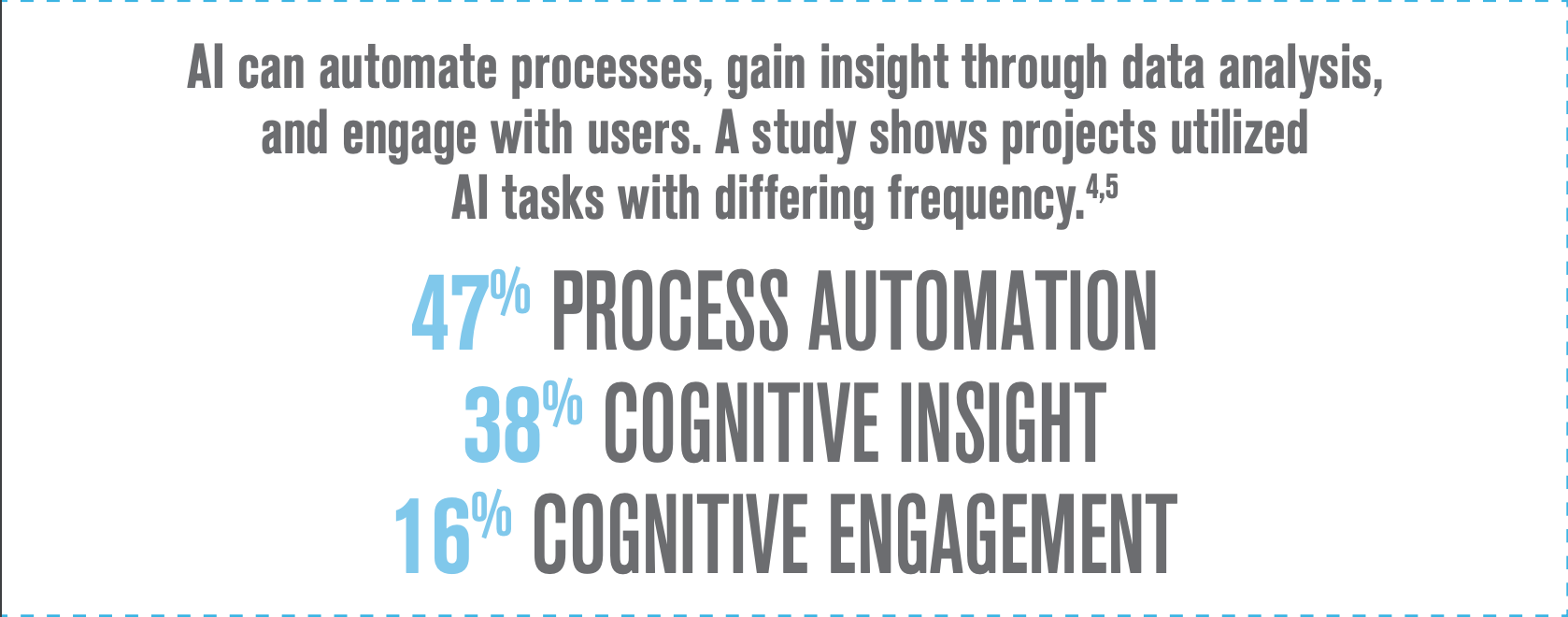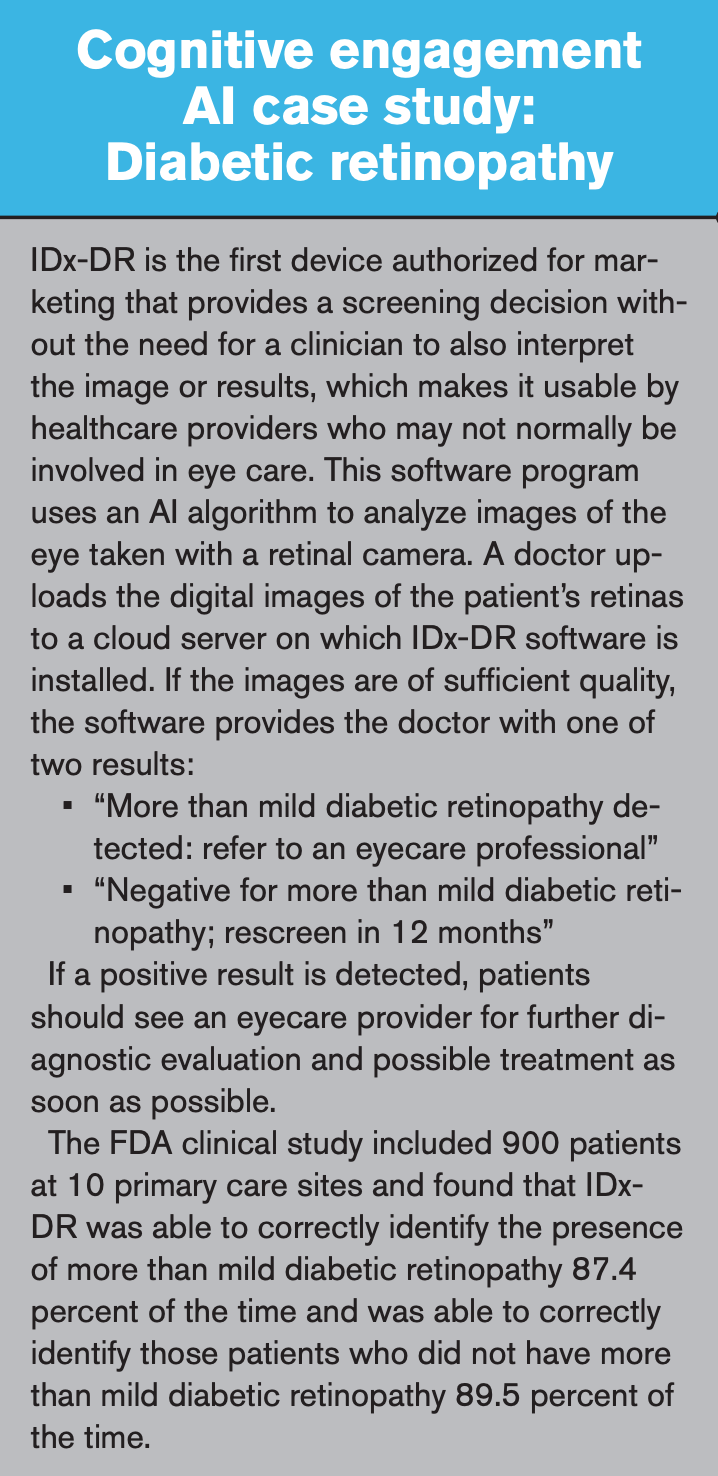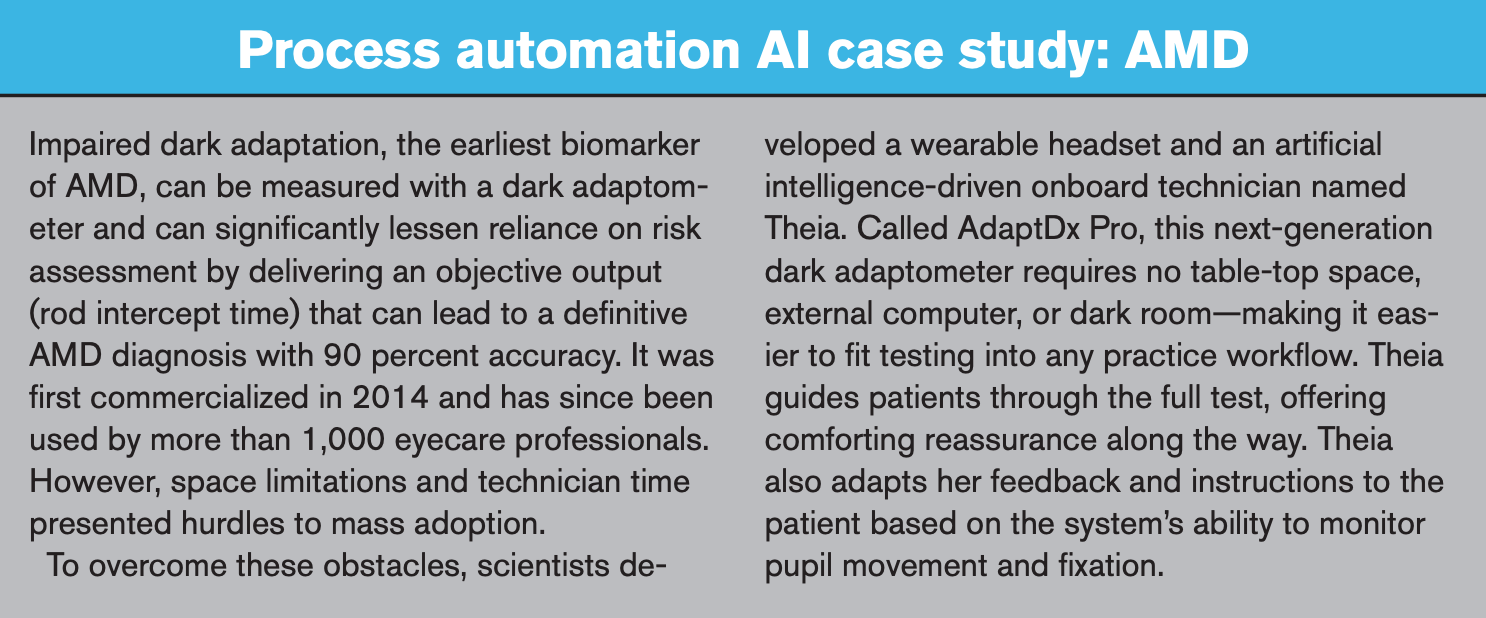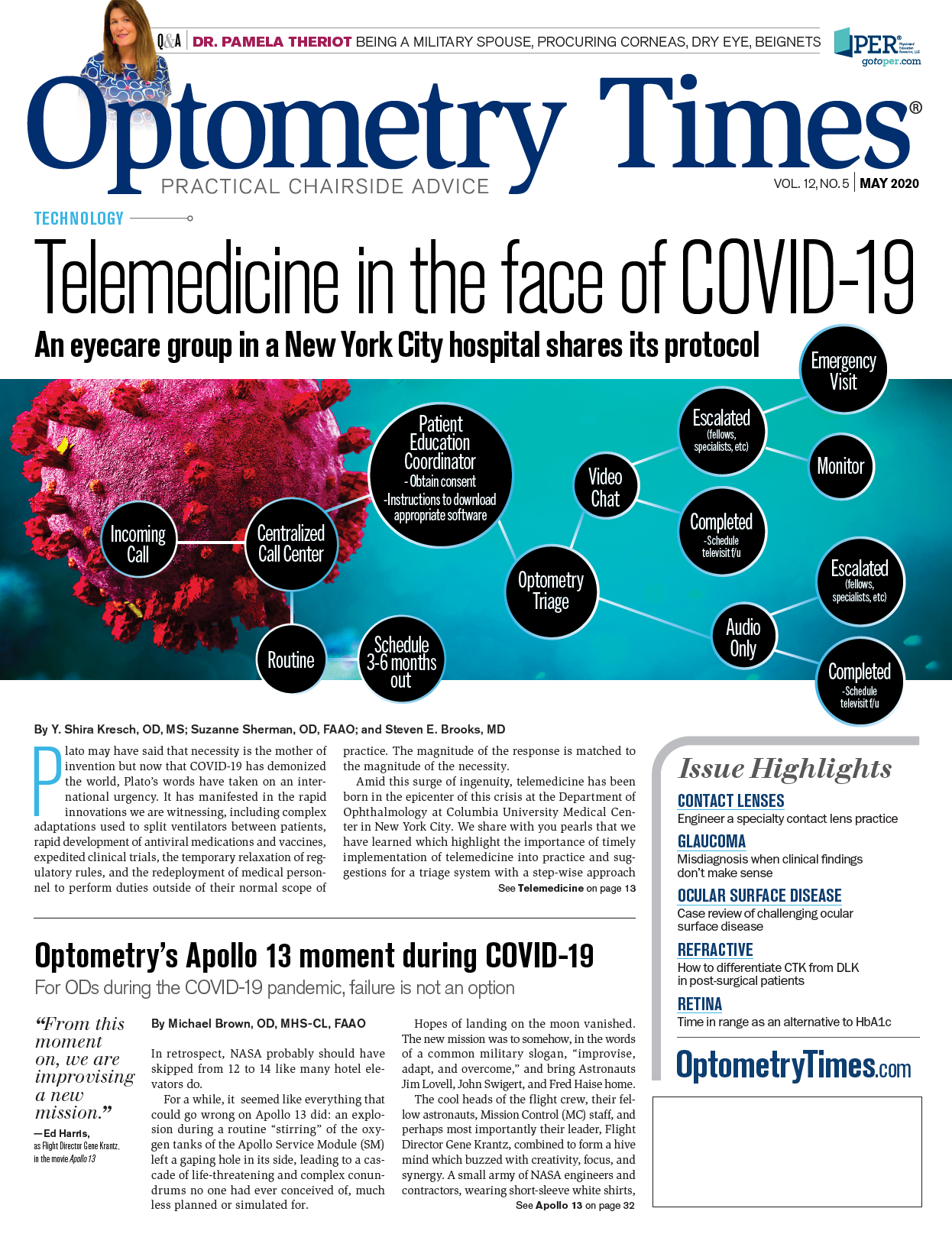Elevate standard of care with artificial intelligence
AI technology promises to improve access, outcomes, and efficiency.




As artificial intelligence becomes more common in screening, diagnosing, and treating eye conditions, it is revolutionizing the optometric industry. AI solves 3 primary concerns in health care: quality of care, time to treat, and cost of treatments. Challenges in data sharing may prevent optometry from realizing the full benefits of AI for some time. In the meantime, innovations in glaucoma and Google’s Deepmind initiative show promise.
Artificial intelligence (AI) is taking the consumer world by storm, so it is no surprise that healthcare innovators are following suit. To the profession’s credit, eye care is leading the way as the first specialty to receive U.S. Food and Drug Administration (FDA) clearance for an autonomous screening tool.1 Recognizing the promise it holds, the U.S. government’s investment in research and development in AI-related technologies was roughly $1.1 billion in 2015 and is expected to substantially increase.1,2
Still, some wonder if there is a potential dark side to AI in medicine. AI in other business sectors was also feared early on and was regarded as a potential job thief and a robber of human touch. However, having experienced some of its simpler benefits over the years-think Amazon Alexa, Google Maps, and more-many have learned to embrace AI technology for its capacity to elevate the human experience rather than fear it based on its imagined propensity to erase humanity.
Related: 10 new treatments in eye care
Indeed, it is important to note that the general goal of AI is not to replace the care provider but rather to augment the ability of humans to provide healthcare.1 The implications of this cannot be understated because there is a synergistic effect when clinicians and AI work together, producing better results than either alone.1,3,4
Here, we will explore how AI helps overcome age-old healthcare conundrums, moving us into a future where access, outcomes, and efficiency are improved so dramatically that it may necessitate a re-evaluation of practice guidelines and standards of care.
Related: Prevention, artificial intelligence, and the future of optometry
Categories of AI solutions
AI can support three distinct needs. It can automate processes, gain insight through data analysis, and engage with users.4 To that end, there are likewise three different types of AI:
1. PROCESS AUTOMATION AI. In a Harvard Business Review study of 152 projects, the most common type of AI (47 percent) was the automation of digital and physical tasks using robotic process automation (RPA) technologies.5 RPA was also found to be the easiest to implement, bringing a quick and high return on investment. An example of this in eye care is AdaptDx Pro guided by Theia, an AI-driven onboard technician that coaches patients through a definitive diagnostic test for age-related macular degeneration (AMD). (See box)
2. COGNITIVE INSIGHT AI. The second most common type of AI project in the study (38 percent) uses algorithms to detect patterns in volumes of data and interpret their meaning.5 This type of machine learning has also garnered significant attention in eye care and has led to the development of a software program designed to perform screening for diabetic retinopathy. The technology, known as IDx-DR (IDx Technologies), underwent the FDA’s Automatic Class III or De Novo premarket pathway and achieved Breakthrough Device designation. (See box)
3. COGNITIVE ENGAGEMENT AI. This type of AI remains immature and was the least common type represented in the study at only 16 percent.5 One of the more common applications of cognitive engagement is the use of chatbots and other automated surrogates that rely on customer input to perform tasks such as answering frequently asked questions. Ideally, future technology may combine elements from all three types of AI into truly comprehensive solutions to modern healthcare challenges.
Related: Look at the retina in a different way
Why we need AI
The traditional representation of the U.S. healthcare economy is based on the iron triangle, which is comprised of three interdependent arms: access, cost, and quality.6 According to this widely accepted theory, improving any one of the three iron triangle vertices may lead to degradation of the other two.7
For example, improving access to care requires resources behind it, which means raising the cost or lowering quality. Improving quality means raising costs or reducing access. Economists, policymakers, payors, providers, and healthcare administrators have grappled with this conundrum for generations and may be finding ways to break free thanks to AI.
Related: AI testing is almost here, and it doesn’t care if ODs are ready
In 2016, the world was treated to an inside look at how this might work and why AI might ultimately decimate the iron triangle. CBS aired an episode of “60 Minutes” in which Watson, a sophisticated IBM supercomputer, was introduced. Watson has the capacity to process all the books in the American Library of Congress-and that’s just the beginning.8 In about a week’s time, Watson read 25 million published medical papers and had the ability to continuously scan the web for the latest medical research and clinical trials. Next, doctors made Watson a medical school resident and fed it 1000 actual cases from cancer patients. Remarkably, in over 99 percent of the cases, Watson identified the same treatment options as a panel of experts. However, Watson went a step further and, in about 30 percent of the cases, also identified a potential but viable treatment that was not previously considered by the panel.
Today, Watson is part of University of North Carolina’s standard of care, according to Ned Sharpless, MD, who was director of the University’s Lineberger Comprehensive Cancer Center. As Dr. Sharpless points out in the CBS segment, AI can absorb the totality of medical research that is produced on a daily basis and make immediate evidence-based decisions. No mortal doctor in practice has access to that depth of knowledge; by embracing AI, any doctor can benefit from it- saving patients from otherwise potentially devastating outcomes.
Related: AI may be the answer for early disease detection
The Practical Benefits of AI
Going back to the iron triangle, technologies like Watson are able to improve the quality of care for more patients, in less time, resulting in lower costs. In short, AI can solve the three primary concerns upon which the U.S.’s modern, yet arguably broken, healthcare system rests.
But as marvelous as this sounds, optometrists may wait decades to realize the benefits of deep-learning, or cognitive insight AI. That is because part of the challenge of AI lies in necessary data sharing and lack of incentive for such exchange to occur.9 However, this too may change as insurers show favor for bundled outcome-based reimbursement over fee-for-service models, a dynamic that might encourage the compilation and free exchange of necessary information.1
In the meantime, keep an eye on future innovations, including Google’s DeepMind initiative that aspires to detect more than 50 diseases based on retinal scan analysis, as well as in glaucoma where researchers are using electronic health record (EHR) data to identify markers beyond intraocular pressure (IOP), allowing doctors to more accurately predict risk and develop new targets for treatment.10
Related: Artificial intelligence might be the future of practice management
References:
1. He J, Baxter SL, Xu J, Xu J, Zhou X, Zhang K. The practical implementation of artificial intelligence technologies in medicine. Nat Med. 2019 Jan;25(1):30-36.
2. Executive Office of the President & National Science and Technology Council Committee on Technology. Preparing for the Future of Artificial Intelligence (2016). Available at: https://obamawhitehouse.archives.gov/sites/default/files/
whitehouse_files/microsites/ostp/NSTC/preparing_for_the_future_of_ai.pdf. Accessed 4/30/20.
3. Wang D, Khosla A, Gargeya R, Irshad H, Beck AH. Deep learning for identifying metastatic breast cancer. Cornell Univ. Available at: https://arxiv.org/abs/1606.05718. Accessed 4/24/20.
4. Lakhani P, Sundaram B. Deep learning at chest radiography: automated classi cation of pulmonary tuberculosis by using convolutional neural networks. Radiology. 2017 Aug;284(2):574-582.
5. Davenport TH, Ronanki R. Artificial Intelligence for the Real World. Harvard Bus Rev. Available at: https://hbr.org/2018/01/artificial-intelligence-for-the-real-world. Accessed 4/24/20.
6. Kissick WL. Medicine’s dilemmas: Infinite needs versus finite resources. New Haven, CT: Yale University Press, 1994.
7. Chang EY. Deepq: Advancing healthcare through artificial intelligence and virtual reality. Available at: https://dl.acm.org/ doi/pdf/10.1145/3123266.3130875. Accessed 4/30/20.
8. Rose C. Artificial intelligence positioned to be a gamechanger. 60 Minutes. Available at https://www.cbsnews.com/ news/60-minutes-artificial-intelligence-charlie-rose-robotsophia/. Accessed 4/24/20.
9. Jiang F, Jiang Y, Zhi H, Dong Y, Li H, Ma S, Wang Y, Dong Q, Shen H, Wang Y. Artificial intelligence in healthcare: past, present and future. Stroke Vasc Neurol. 2017 Jun 21;2(4):230- 243.
10. Baxter SL, Marks C, Kuo TT, Ohno-Machado L, Weinreb RN. Machine Learning-Based Predictive Modeling of Surgical Intervention in Glaucoma Using Systemic Data From Electronic Health Records. Am J Ophthalmol. 2019 Dec;208:30-40.

Newsletter
Want more insights like this? Subscribe to Optometry Times and get clinical pearls and practice tips delivered straight to your inbox.